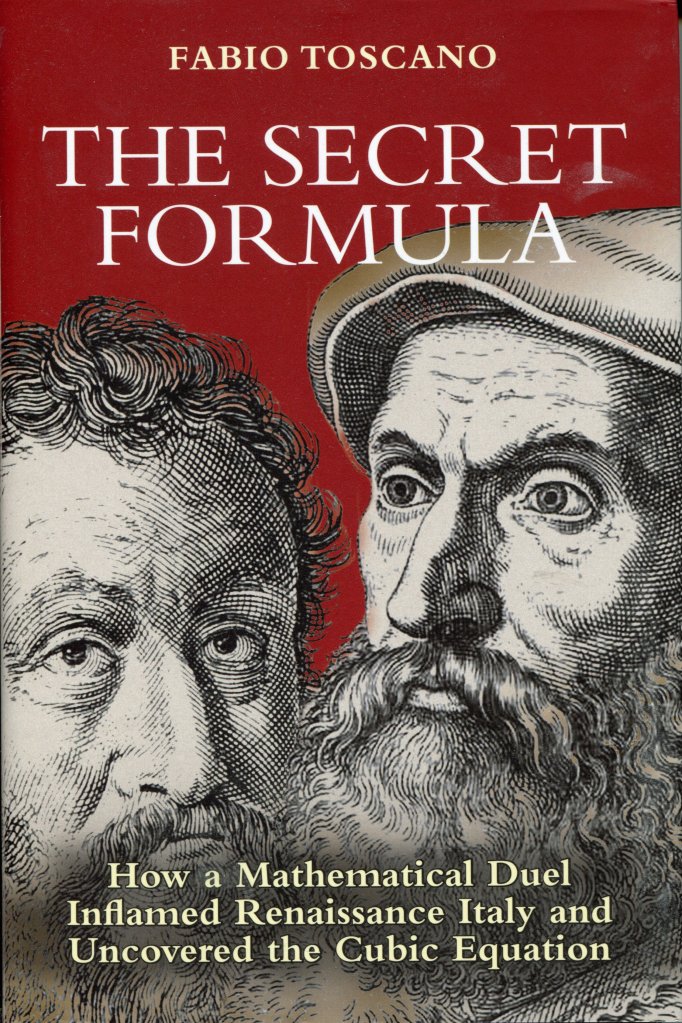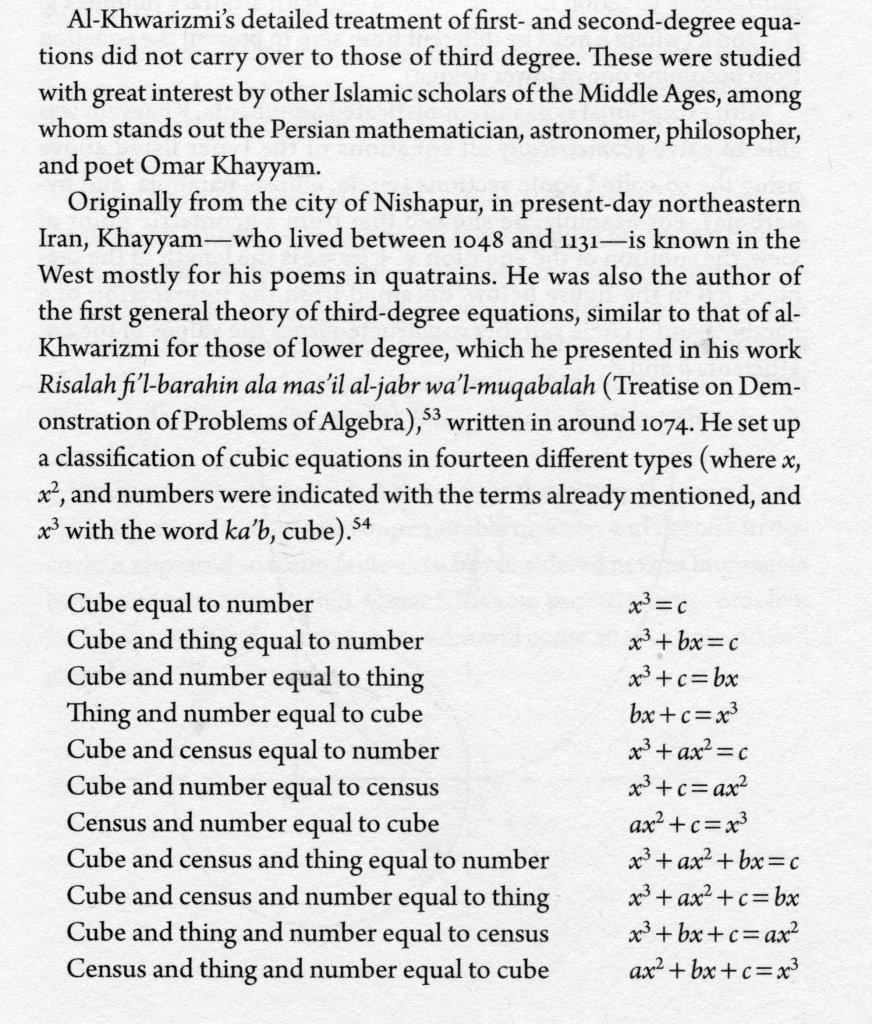The Early Modern period is full of disputes between scholars about questions of priority and accusations of the theft of intellectual property. One reason for this is that the modern concepts of copyright and patent rights simply didn’t exist then, however, that is not the topic of this post. One of the most notorious disputes in the sixteenth century concerned Niccolò Fontana Tartaglia’s discovery of the solution to one form of cubic equation and Gerolamo Cardano’s publication of that solution, despite a promise to Tartaglia not to do so, in his book Artis Magnae, Sive de Regulis Algebraicis Liber Unus, commonly known as the Ars Magna in 1545. A version of this story can be found is every general history of mathematics book and there are numerous versions to be found on the Internet. I blogged about it twelve years ago and maths teacher and historian, Dave Richeson wrote about it just last month in Quanta Magazine.
Despite all of this, I am going to review a book about the story that I recently acquired and read, Fabio Toscano, The Secret Formula: How a Mathematical Duel Inflamed Renaissance Italy and Uncovered the Cubic Equation.[1]

Unlike most of my book reviews this is not a new book, it was originally published in Italian as, La formula segreta, in 2009 and the English translation appeared in 2020. I caught a glimpse of it on the Princeton University Press website at half price in their summer sale and on a whim decided to buy it.[2] I’m glad that I did, as it is an excellent retelling of the story using all of the original documents, which adds a whole new depth to it, not found in the popular versions.
Toscano’s book, which is comparatively short, has six chapters each of which deals with a distinctive aspect of the sequence of historical events that he is narrating. The opening chapters introduces one of the principal characters in this story Niccolò Fontana, describing his lowly birth, his facial disfigurement delivered by a soldier during the 1512 storm of Brescia, which gave him the stutter by which he was known, Tartaglia. How the autodidactic mathematician became an abaco master, a private teacher of arithmetic, algebra, bookkeeping and elementary geometry.
The second chapter is a brief sketch of history of algebra up to the Renaissance. The elementary nature of ancient Egyptian algebra, the much more advanced nature of Babylonian algebra including the partial general solution of the quadratic equation. Partial, because the Babylonians didn’t acknowledge negative solutions. Here we have one of the few, in my opinion, failures in the book. There is no mention whatsoever of the Indian contributions to the evolution of algebra. This is important as it was Brahmagupta who, in the sixth century CE, introduced the full arithmetic of both positive and negative numbers and the full general solution of the quadratic equation. More importantly the Islamic algebraists took their knowledge of algebra from the Indians and in particular Brahmagupta. Another failure in this section is that Toscano repeats the standard myth of the House of Wisdom. Very positive is the fact that he explains the terminology of rhetorical algebra, the problems are all written out in words not symbols. He also explains that whereas we now just handle quadratic or cubic equations through the general form, in the Renaissance every variation was regarded as a separate equation. So, for example, if the x2 is missing from a cubic equation, this is a new equation that is handled separately. There are in fact, according to Omar Khayyam, fourteen different types of cubic equation. Apart from the omission of Indian algebra this whole chapter is excellent.

The third chapter takes us to the heart of the story and the event that made Tartaglia famous and would eventually lead to his bitter dispute with Cardano, the public contest with Antonio Maria Fior. In the most influential mathematics book of the era, his Summa de arithmetica, geometria, proportioni et proportionalita (Summary of arithmetic, geometry, proportions and proportionality) published in Venice in 1494, Luca Pacioli (c. 1447–1517) had stated that there was no possible general solution to the cubic equation, Fior had, however, acquired a general solution to the cubic equations of the form x2 + bx = c and thought he could turn this into capital for his career. He challenged Tartaglia to a public contest thinking he held all the trumps. Unfortunately, for him Tartaglia had also found this solution, so the contest turned into a debacle for Fior and a great triumph for Tartaglia. If you want to know the details read the book. Toscano’s account of what happened, based on the available original sources is much more detailed and informative that the usual ones. We also get introduced to Messer Zuanne Tonini de Coi, another mathematician, who doesn’t usually get mentioned in the general accounts of the story but who plays a leading role in several aspects of it. Amongst other things, he was the first who tries to get Tartaglia to divulge the partial solution of the cubic that he has discovered, and it was he, who he first told Cardano about Tartaglia’s discovery.
In chapter four we meet the villain of the story the glorious, larger than life, Renaissance polymath, Gerolamo Cardano. We get a sympathetic description of Cardano’s less than auspicious origins and his climb to success as a physician against all the odds. Toscano does not over emphasise Cardano’s oddities and he had lots of those. We now get a very detailed account, once more based on original documents, of Cardano’s attempts to woo Tartaglia and seduce the secret of the partial cubic solution out of him. Cardano’s seduction was eventually successful, and he obtained the solution but only after swearing a solemn oath to reveal the solution to nobody until Tartaglia had published in his planned book.
Chapter five takes us to Cardano’s breaking of that oath, his, I think justifiable reasons for doing so, and Tartaglia’s understandable outrage. The chapter opens with more exchanges about Tartaglia’s solution, which Cardano hasn’t truly understood, because of an error in Tartaglia’s encrypted poetical revelation of it. Having cleared this up Tartaglia begins to panic because Cardano is planning to publish a maths book his, Practica arithmetice et mensurandi singularis (The Practice of Arithmetic and Simple Mensuration), and he fears it will include his solution, it didn’t, panic over for now. We now get introduced to Cardano’s brilliant pupil and foster son, Lodovico Ferrari. Between the two of them, starting from Tartaglia’s solution, they find the general solutions of the cubic and the quartic or biquadratic equations putting algebra on a whole new footing but are unable to publish because of Cardano’s oath to Tartaglia. However, in 1542, Cardano and Ferrari travelled to Bologna and discovered in a notebook of Scipione Dal Ferro Tartaglia’s partial solution of the cubic made twenty years earlier than Tartaglia and obviously the source of Fior’s knowledge of the solution. Cardano no longer felt constrained by his oath and in 1545, his Ars Magna was published by Johannes Petreius in Nürnberg, containing all the algebra that he and Ferrari had developed but giving full credit to Scipione Dal Ferro and Tartaglia for their contributions. Tartaglia went ballistic!
The closing chapter deals with the final act, Tartaglia’s indignation over what he saw as Cardano’s treachery and the reaction to his accusations. Tartaglia raged and Cardano remained silent. Although, he had been very vocal in obtaining the cubic solution from Tartaglia, Cardano now withdrew completely from the dispute, leaving Ferrari to act as his champion. Tartaglia and Ferrari exchanged a total of twelve pamphlets, six each, full of polemic, invective, accusations, and challenges. Tartaglia trying, the whole time, to provoke Cardano into a direct response, accusing him of ghost-writing Ferrari’s pamphlets. Ferrari, in turn, constantly challenged Tartaglia to a face-to-face public confrontation, which he steadfastly rejected. Toscano reproduces a large amount of the contents of those pamphlets, upon which he judiciously comments. It is this engagement by the author that makes the book such a good read. Tartaglia finally caved in, probably as a condition of a new job offer, and met Ferrari in the public arena in Milan, fleeing the city on the evening of the first day of the confrontation, his reputation in tatters. What exactly took place, we don’t know, as Cardano and Ferrari never commented on the meeting, and we have only Tartaglia’s account that relates that he realised that the crowd was stacked against him with Ferrari’s supporters, and he could never win and so he departed.
Given the nature of the book, it has no illustrations. However, given the authors extensive use of both primary sources as well as authoritative secondary sources, it has an impressive number of endnotes, unfortunately not footnotes. Most of these are simple references to the source quoted and here the book uses a convention that I personally dislike. These references are mostly just something like [21.e]. The authors in the bibliography are sequentially numbered and if the author of more than one text these are identified by the small case letters. So, you are interested in the origin of a quote, you go to the endnotes, find there such a number, and then leaf through the bibliography to find out who, what, why, where! I do not like! Many of the items in the bibliography are texts from Italian historians, so the English edition has a short, but high quality, extra list of English titles on the topic. There is an excellent index.
It may seem that I have revealed too much of the contents of the book to make it worth reading but I have only sketched the outline of the story as it appears in the book, a story, which as I said at the beginning is very well know, the devil is as they say in the detail. By his very extensive use of the original sources, Toscano has given the popular story a whole new dimension, making his book a totally fascinating read for anybody interested in the history of mathematics. His book is also a masterclass in how to write high quality popular history of mathematics.
[1] Fabio Toscano, The Secret Formula: How a Mathematical Duel Inflamed Renaissance Italy and Uncovered the Cubic Equation, Translated by Arturo Sangalli, Princeton University Press, Princeton and Oxford, 2020
[2] More accurately the dastardly Karl Galle drew my attention to it, and I couldn’t resist the temptation, as it was not only cheap but came with free p&p. When I ordered it, I had forgotten that PUP distribute their book in Europe out of the UK. I try to avoid ordering books from the UK because, since Brexit, I now have to pay customs duty on book from the UK, on top of which the German postal service adds a €6 surcharge for paying the customs duty in advance, this would, in this case almost double the cost of the book. Normally, when I receive books from the UK, I get a note in my post box and have to go to the post office to pay the money due and pick up the book. For some reason, in this case, the postman simply delivered the book despite the label saying how much I was supposed to pay and so I didn’t have to pay it. You win some, you lose some!